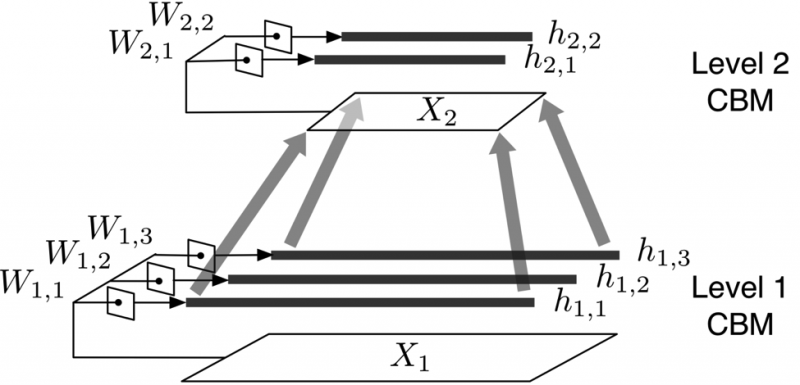A two-level Recursive Convolutional Bayesian Model (RCBM). W: filter matrices; h: activation vectors; X: input dynamics. The upper-level input dynamic is constructed by max-pooling the activation vectors that are one level below it. Credit: Carnegie Mellon University Electrical and Computer Engineering
Everything in social media evolves with time; understanding the patterns of this change is essential for any social-media application. However, in terms of research on identifying interaction patterns, little was done to explore how exactly these interactions behave at multiple time scales, despite the fact that this is hugely important in practice. For example, to make a business popular on Yelp, it is important to use short-term (e.g., a few months) interactions to build and sustain long-term (e.g., a couple of years) popularity.
Multiple-scale pattern mining using deep learning
In their recent paper published in PLoS One, Ph.D. student Huan-Kai Peng and Professor Radu Marculescu, from Carnegie Mellon University's Department of Electrical and Computer Engineering, propose a new way to identify the intrinsic dynamics of interaction patterns at multiple time scales.
Their method involves building a deep-learning model that consists of multiple levels; each level captures the relevant patterns of a specific temporal scale (see Figure 1). The newly proposed model can be also used to explain the possible ways in which short-term patterns relate to the long-term patterns. For example, it becomes possible to describe how a long-term pattern in Twitter can be sustained and enhanced by a sequence of short-term patterns, including characteristics like popularity, stickiness, contagiousness, and interactivity (see Figure 2).
Applications: forecasting and anomaly detection
Peng and Marculescu demonstrate how to use this new method to build a forecasting engine that is far more accurate than the standard approaches proposed so far. Another application targets anomaly detection, that is, identifying cases when the user interactions over social media are abnormal (i.e., do not conform with their expected patterns). For Twitter, such abnormal cases would include major disasters (e.g., tsunami, crashes) or urgent messages (e.g., swine flu). For Yelp, such cases would include abandoned places (e.g., dead malls) or adult entertainment (e.g., strip club).
The level-1 compositional structures of Twitter social dynamics identified using a two-level RCBM. They represent the fine-grained signatures of Twitter social dynamics including the baseline, popularity, contagiousness, stickiness, and interactivity. Credit: Carnegie Mellon University Electrical and Computer Engineering
Next step: social-dynamics engineering
The CMU researchers are currently developing new methods that can use the mined patterns to "engineer" social dynamics. In other words, the objective now consists of calculating the best recommended intervention that fits the intrinsic patterns extracted from social media, while maximally achieving some prescribed goals. For instance, one such goal can be to achieve a predefined long-term popularity level with the lowest possible intervention cost.
"We wish to extend the use of Deep Learning beyond prediction or understanding," said the corresponding author. "Indeed, we want to be able to tell people how to use social media in the best possible way according to existing historical data." If successful, such an extension can lead to endless applications ranging from mobile sensors to macroeconomics.
More information: Peng H-K, Marculescu R (2015) Multi-Scale Compositionality: Identifying the Compositional Structures of Social Dynamics Using Deep Learning. PLoS ONE 10(4): e0118309. DOI: 10.1371/journal.pone.0118309
Journal information: PLoS ONE
























